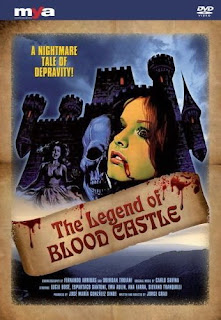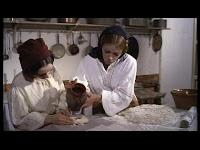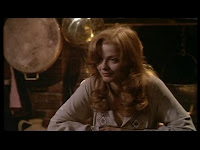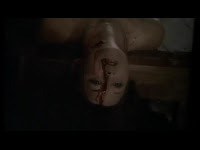 Director: Jorge Grau
Director: Jorge Grau
Release date: 1973
Contains spoilers
I have read that this is one of the most accurate tellings of the Erzsébet Báthory story. It is not. Not for the inaccuracy twixt film and history/legend but because it isn’t the Báthory story at all. It is made clear in the dialogue that this Erzsébet (Lucia Bosé), who is a marquise not a countess, had an infamous ancestor who bathed in virgin’s blood also called Erzsébet. Indeed her surname isn’t given but we can assume that she and her husband Karl (Espartaco Santoni) share the name Ziemmer.
Thus this is inspired by the Báthory story – and the main character is inspired by her crimes – allowing Grau to move into uncharted territories and giving a license to do what he liked with the story, with impunity, though he takes many elements of the legend. He also plays with other traditional vampire myths and historical vampire stories. It is this rich detail that really makes this film, although there are times where there are so many concepts one wishes that he had paused for breath and explored them a little more, and the detail starts in the first scenes as the opening credits roll along.
 We begin with a procession of villagers and a naked boy upon a white horse. Karl, watching from a window, calls this the Test of the Horse and it is an immediate launch into traditional vampire detection methods – where a virgin horse ridden by a (naked) virgin is used to find the vampire’s tomb. This occasionally appears in films (in a variant, at least). We saw it in the 1979 Dracula and also referenced in Subspecies. This sets the tone of the film, exploring a lot of traditional elements whilst also referencing the more modern vampire that came from literature.
We begin with a procession of villagers and a naked boy upon a white horse. Karl, watching from a window, calls this the Test of the Horse and it is an immediate launch into traditional vampire detection methods – where a virgin horse ridden by a (naked) virgin is used to find the vampire’s tomb. This occasionally appears in films (in a variant, at least). We saw it in the 1979 Dracula and also referenced in Subspecies. This sets the tone of the film, exploring a lot of traditional elements whilst also referencing the more modern vampire that came from literature.
 The grave of the vampire is found and dug open. We see the corpse, arms upwards fingers bloodied (as though trying to get out of the coffin after being buried alive, I’ll return to this). Without thought he is quickly staked and blood comes to the mouth. We see a young girl, Irina (Raquel Ortuño), approach a guard. She asks him to collect some of the vampire’s blood for her when the crowd has gone. She gives him a bribe and a pitcher in which to collect it. Witchcraft? The film does have hints of witchcraft but this part is based on traditional vampire myth.
The grave of the vampire is found and dug open. We see the corpse, arms upwards fingers bloodied (as though trying to get out of the coffin after being buried alive, I’ll return to this). Without thought he is quickly staked and blood comes to the mouth. We see a young girl, Irina (Raquel Ortuño), approach a guard. She asks him to collect some of the vampire’s blood for her when the crowd has gone. She gives him a bribe and a pitcher in which to collect it. Witchcraft? The film does have hints of witchcraft but this part is based on traditional vampire myth.
 We see Irina and her friend Inge (Ghike) making bread with the blood. This is blood bread – a traditional vampire deterrent and we can quote the entry in the Vampire Encyclopedia: “The custom found in parts of Poland centuries ago, where bread was supposedly made from the blood of a vampire. Considered a powerful means of protecting one’s family from attacks of the undead, the bread was made by gathering a small amount of blood from inside the coffin of a destroyed vampire, normally possible because of the great amounts of blood that were said to gush from the body. The liquid was then baked into a kind of bread. Consuming it was said to make the person invulnerable to the vampire.” Interestingly Inga is not meant to be there, she is not of the household, but then the housekeeper (Ana Farra) gets more upset when it is apparent the girls method of making the bread is incorrect.
We see Irina and her friend Inge (Ghike) making bread with the blood. This is blood bread – a traditional vampire deterrent and we can quote the entry in the Vampire Encyclopedia: “The custom found in parts of Poland centuries ago, where bread was supposedly made from the blood of a vampire. Considered a powerful means of protecting one’s family from attacks of the undead, the bread was made by gathering a small amount of blood from inside the coffin of a destroyed vampire, normally possible because of the great amounts of blood that were said to gush from the body. The liquid was then baked into a kind of bread. Consuming it was said to make the person invulnerable to the vampire.” Interestingly Inga is not meant to be there, she is not of the household, but then the housekeeper (Ana Farra) gets more upset when it is apparent the girls method of making the bread is incorrect.
 A magistrate (Ángel Menéndez), with a name in the English language dub suspiciously like Helsing, arrives at the inn. He is intercepted by Karl who craves intelligent conversation. At the castle Erzsébet complains about becoming old and the housekeeper mentions the acts of her ancestor – whose husband preferred making war. Karl prefers his falcons and we see a glimpse of Karl becoming obviously excited as a falcon rips its prey apart. In the inn Karl goes to bed. The innkeepers daughter Marina (Ewa Aulin) is clearly interested in him and an old witch, Carmilla (lola Gaos), gives her a love salve. She goes to Karl and he is interested, but he grabs her neck violently and it is clear he is a psychopathically sadistic individual – she leaves his room. In the morning the witch looks at Karl and tells Marina that death is in his eyes. The reference in character name to Carmilla needs no further comment.
A magistrate (Ángel Menéndez), with a name in the English language dub suspiciously like Helsing, arrives at the inn. He is intercepted by Karl who craves intelligent conversation. At the castle Erzsébet complains about becoming old and the housekeeper mentions the acts of her ancestor – whose husband preferred making war. Karl prefers his falcons and we see a glimpse of Karl becoming obviously excited as a falcon rips its prey apart. In the inn Karl goes to bed. The innkeepers daughter Marina (Ewa Aulin) is clearly interested in him and an old witch, Carmilla (lola Gaos), gives her a love salve. She goes to Karl and he is interested, but he grabs her neck violently and it is clear he is a psychopathically sadistic individual – she leaves his room. In the morning the witch looks at Karl and tells Marina that death is in his eyes. The reference in character name to Carmilla needs no further comment.
The magistrate is there for the posthumous trial of the vampire and this is interspersed with the actions of Erzsébet. For convenience I shall split these up. The vampire’s corpse is in the courtroom and his name was Plogojowitz (imdb suggests Plojovitz) – a reference to the case of Peter Plogojowitz, a historical vampire case from 1725. He is questioned (of course he does not answer) and witnesses are called. Of those officiating Karl seems amused by the concept of a vampire but Doctor Silas (Silvano Tranquilli) is fiercely unconvinced. He mentions plague and Plogojowitz being buried alive (presumably because of his bloodied fingernails). Later he quotes Voltaire who stated that vampires were actually userers and their ilk who “did not live in cemeteries, they preferred beautiful palaces”.
 Carmilla talks of a parchment, potion and pendant she sold to Plogojowitz. The pendant was cursed, all who wore it died within a year, thus she never wore it herself. The most damning evidence comes from the widow Plogojowitz (María Vico) and her daughter Nadja (Franca Grey). Nadja states that her father came to her after his death and kissed her – not as a father kisses a daughter. He then bit her neck, to drink her blood, and shows the cut left behind. Later Karl realises that the marks are from the broken links on a chain she wears. Plogojowitz is sentenced to be beheaded, his head burnt and the ashes scattered in the river. After the trial Karl determines to wear the pendant to disprove the curse and collects the potion and parchment from Plogojowitz’ home.
Carmilla talks of a parchment, potion and pendant she sold to Plogojowitz. The pendant was cursed, all who wore it died within a year, thus she never wore it herself. The most damning evidence comes from the widow Plogojowitz (María Vico) and her daughter Nadja (Franca Grey). Nadja states that her father came to her after his death and kissed her – not as a father kisses a daughter. He then bit her neck, to drink her blood, and shows the cut left behind. Later Karl realises that the marks are from the broken links on a chain she wears. Plogojowitz is sentenced to be beheaded, his head burnt and the ashes scattered in the river. After the trial Karl determines to wear the pendant to disprove the curse and collects the potion and parchment from Plogojowitz’ home.
 Meanwhile Erzsébet has, in anger, struck Irina and the resultant nosebleed splattered her hand with blood. For a few moments it seemed that the skin became whiter. She tries to use dove’s blood – something Irina uses to firm her breasts – but it has no effect. The housekeeper suggests maiden’s blood is necessary. During these scenes we get more evidence of Karl’s instabilities as he seems to be on the verge of violence with Inga before letting her leave his home.
Meanwhile Erzsébet has, in anger, struck Irina and the resultant nosebleed splattered her hand with blood. For a few moments it seemed that the skin became whiter. She tries to use dove’s blood – something Irina uses to firm her breasts – but it has no effect. The housekeeper suggests maiden’s blood is necessary. During these scenes we get more evidence of Karl’s instabilities as he seems to be on the verge of violence with Inga before letting her leave his home.
 Erzsébet experiments by arranging for an infant girl’s hand to be cut. She rubs the blood on her face – even licking at the blood from the corner of her mouth. Later we hear that the experiment was successful but, of course, how could she possibly avail herself of more blood. Interestingly, unlike Hammer’s Báthory adaptation, Countess Dracula, Grau does not have Erzsébet getting very noticeably younger. This might all be in her own head and when she later ages, it is how she sees her own reflection. It seems to me, given how strong the references and research was in the film that this was a commentary and vampires and reflection - though in this case it meant that she couldn't stand her own reflection.
Erzsébet experiments by arranging for an infant girl’s hand to be cut. She rubs the blood on her face – even licking at the blood from the corner of her mouth. Later we hear that the experiment was successful but, of course, how could she possibly avail herself of more blood. Interestingly, unlike Hammer’s Báthory adaptation, Countess Dracula, Grau does not have Erzsébet getting very noticeably younger. This might all be in her own head and when she later ages, it is how she sees her own reflection. It seems to me, given how strong the references and research was in the film that this was a commentary and vampires and reflection - though in this case it meant that she couldn't stand her own reflection.
 Suddenly Karl is dead and placed in the family vault. Then Erzsébet helps the man from his coffin – it is clear he is alive and well. The jump jars and almost feels as though part of the story is missing. Actually the events leading to this are relayed at the end of the film but it did make the story jerk cinematically. Essentially he fakes his own death, using Plogojowitz' potion to put himself into a deathlike trance, and has agreed to help Erzsébet get the blood she needs, thus renewed youth, in return he gets to leave (it seems with Marina). It is clear that Plogojowitz was buried alive, having imbibed the potion, though I wish Grau had explored this more.
Suddenly Karl is dead and placed in the family vault. Then Erzsébet helps the man from his coffin – it is clear he is alive and well. The jump jars and almost feels as though part of the story is missing. Actually the events leading to this are relayed at the end of the film but it did make the story jerk cinematically. Essentially he fakes his own death, using Plogojowitz' potion to put himself into a deathlike trance, and has agreed to help Erzsébet get the blood she needs, thus renewed youth, in return he gets to leave (it seems with Marina). It is clear that Plogojowitz was buried alive, having imbibed the potion, though I wish Grau had explored this more.
 Of course I mentioned that it was clear that Karl was psychopathically a sadist and he seems to gain the (possibly sexual) release he needs from being able to act like a vampire and become a murderer. The villagers all believe the marquis has returned from the dead. There is an interesting moment, when he kidnaps and murders Nadja, that had bats being found on her otherwise empty bed – he had left the shutters open on the windows – causing the mother to scream. This, like the Dracula and Carmilla reference, was for the modern audience (boys later torture a bat calling it a vampire to underline this point) as bats were not really part of traditional lore. He becomes more and more comfortable with his role and we see both controlled and frenzied stabbings as well as an actual biting the neck open.
Of course I mentioned that it was clear that Karl was psychopathically a sadist and he seems to gain the (possibly sexual) release he needs from being able to act like a vampire and become a murderer. The villagers all believe the marquis has returned from the dead. There is an interesting moment, when he kidnaps and murders Nadja, that had bats being found on her otherwise empty bed – he had left the shutters open on the windows – causing the mother to scream. This, like the Dracula and Carmilla reference, was for the modern audience (boys later torture a bat calling it a vampire to underline this point) as bats were not really part of traditional lore. He becomes more and more comfortable with his role and we see both controlled and frenzied stabbings as well as an actual biting the neck open.
 However, Erzsébet’s sanity struggles with the enormity of her crimes and her own guilt. She becomes haunted by the dead, although it is clear that these were meant to be no phantoms but figments of her own imagination, hallucinations born of the guilt she felt. Indeed, in many respects, Erzsébet could be seen to be the victim here – married to an emotionally distant husband, himself fighting his own violent urges, and encouraged by the housekeeper – whose motivations are unclear (but probably thought she was doing the right thing by her mistress). Of course she is still a criminal, a murderess though she did not kill any of the girls herself as she arranged their deaths for her own vanities.
However, Erzsébet’s sanity struggles with the enormity of her crimes and her own guilt. She becomes haunted by the dead, although it is clear that these were meant to be no phantoms but figments of her own imagination, hallucinations born of the guilt she felt. Indeed, in many respects, Erzsébet could be seen to be the victim here – married to an emotionally distant husband, himself fighting his own violent urges, and encouraged by the housekeeper – whose motivations are unclear (but probably thought she was doing the right thing by her mistress). Of course she is still a criminal, a murderess though she did not kill any of the girls herself as she arranged their deaths for her own vanities.
There is so much referenced in this that the film is a vampire fan's joy. The film itself, unusually, has very little of the gothic sumptuousness that one would expect. Grau draws a cold film around us – and this works as the subject matter suits such coldness. The jump in narrative is problematic on first view – though after that one knows that the narrative has been less jumped and more delayed. As for the DVD, Mya Communications should be commended for making this available – but one thing irked.
Two scenes are restored into the English dub from the Spanish. As such they are subtitled, fair enough. The DVD has the Spanish, Italian and English soundtracks and yet no subtitles for the film (other than the two scenes). Other than that, ideally a digital restore would have been done but, all in all, it is great that they have made this rare piece of vampire cinema available. 7 out of 10.
The imdb page is here.
Tuesday, June 23, 2009
The Legend of Blood Castle – review
Posted by
Taliesin_ttlg
at
9:06 AM
![]()
Labels: Carmilla, Erzsébet Báthory, folklore, vampire
Subscribe to:
Post Comments (Atom)
















9 comments:
Hm, animal abuse? Too bad, that pollutes even a good film. Anyways, I´m interested of this "blood-bathing mistress of the castle desiring youth and beauty" legend.
christine - the bathory legend is covered via several films and books so I'm sure you can find out more without seeing the bat abuse.
\indeed two new films are due based on the legend/history
Hey Andy,
I've been meaning to see this film for a while and actually forgot about it till now. I've been meaning to see it alongside Blood & Roses to add to my 'Bathory/Carmilla/Female Vampire' collection.
Speaking of which, have you seen the new BATHORY film starring Anna Friel and directed by Juraj Jakubisko, it's is a Slovak film.
Bathory
I assume when you say it's missing the Gothic Sumptuousness, you meant the decor and castle trappings present in Hammer Horror films? I am confused because from the screencaps you provided it actually looks quite lush with it.
Gabriel
I haven't seen the Anna Friel vehicle yet - but thanks for the link as it is one of the two I was referring to in my response to Christine.
The sumptuousness is hard to put a finger on and perhaps I used the wrong word - it was a long review! It is an atmosphere (rather than within the visual design). Hammer and much of the contemporary Euro-horror had a rich, thick atmosphere this eschewed. It felt cold, distant perhaps, a little like Karl's character.
Yes, I liked the Hammer´s Countess Dracula - it is a bit slow-moving, but it has had rich, gorgeous atmosphere of Gothic Romance fairytale I loved. Not seen the new Bathory film yet - only trailer!
I'm actually impressed with how much lore the makers of this film have utilised!
They obviously did their research. Although, whether or not this has been translated into a good movie, I can not presently say...
To be honest, as I wrote the review I couldn't help but thnik it might be the sort of film (due to the lore) that you'd enjoy, AV
As long as there's staking, cross-wielding, fangs and holy water being splashed about, I'm happy ;)
All of which are missing from this - as it is killers obsessed with blood, along with peasant superstition leading to traditional detection methods - yet I suspect you will still be happy :)
Post a Comment